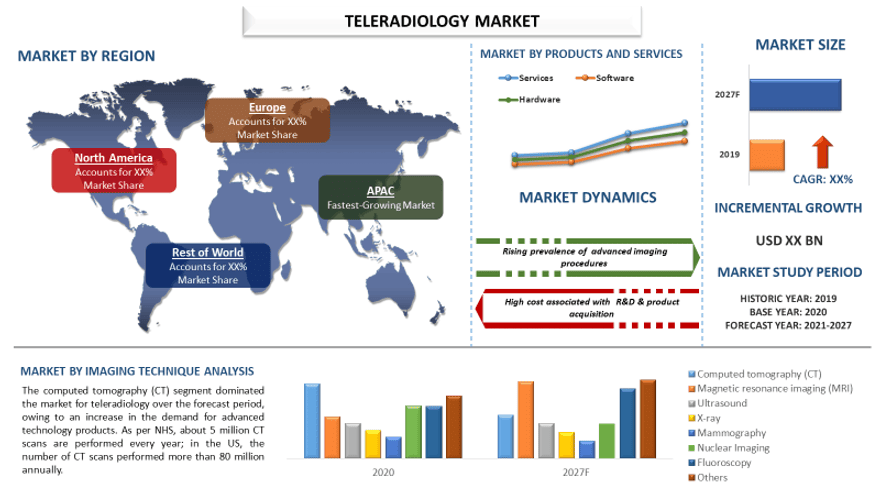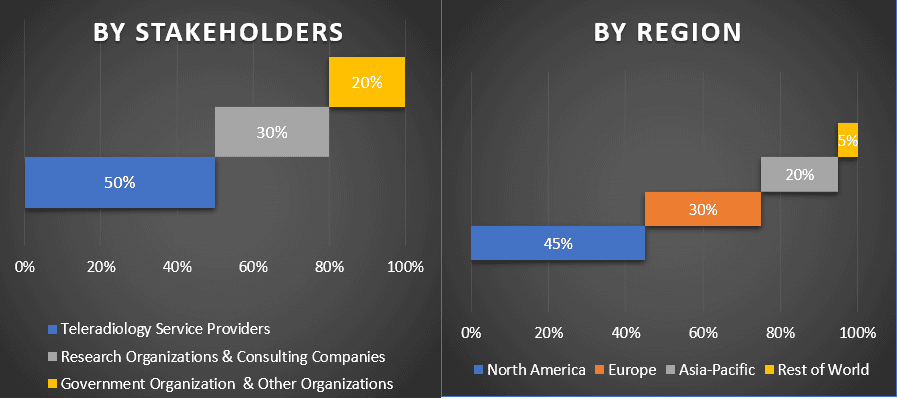- Home
- About Us
- Industry
- Services
- Reading
- Contact Us
Teleradiology Market: Current Analysis and Forecast (2021-2027)
Emphasis on Product and Services (Services, Software, Hardware); Image Technique Analysis (Computed Tomography (CT), Magnetic Resonance Imaging (MRI), Ultrasound, X-Ray, Mammography, Nuclear Imaging, Fluoroscopy, and Others); End-Users (Hospitals & Clinics, Ambulatory Surgical Centers, Home Care Settings, Others); Region/Country

The global teleradiology market is anticipated to grow with an elevated CAGR of ~15% during the forecast period (2021-2027). Teleradiology is the device that provides the transmission of radiological images from one location to other, enabling them to be physicians diagnose and testing. These devices can be complex electronically powered machines or basic machines and have wide applications in the healthcare industry.
With the rapid advancement in technology and rising awareness among the target population to diagnose and treated, many industry players are focusing on expanding their product portfolio by launching new products in the market due to which the teleradiology market is witnessing an uptick all over the globe. Additionally, according to the WHO, annually, more than 3,600 million diagnostic radiological examinations are performed worldwide. This will be one of the most important factors for the industry expansion in the approaching years. In addition, the incidence of chronic disorders, such as cardiovascular diseases (CVDs), cancer, and chronic respiratory disease, is on the rise.
Furthermore, the demand for teleradiology is increasing on account of the growing number of people having chronic disorders. Furthermore, according to the Centers for Disease Control and Prevention, in the U.S., one person dies every 36 seconds from CVDs and about 659,000 people die from heart diseases each year, which is 1 in every 4 deaths.. This global estimate for disability is on the rise due to population aging and the rapid spread of chronic diseases, as well as improvements in the methodologies used to measure diseases. For instance, 17.9 million people die each year from CVDs, which is an estimated 32% of all deaths worldwide, and 85% of all CVD deaths are due to heart attacks and strokes.
Agfa-Gevaert Group, teleradiology Solutions, Koninklijke Philips N.V., Everlight Radiology, GE Healthcare, MEDNAX Inc., ONRAD, Inc. RamSoft, Inc., Virtual Radiologic, Medica Reporting Ltd. are some of the prominent players operating in the teleradiology market. Several M&As along with partnerships have been undertaken by these players to facilitate customers with new varieties of teleradiology devices.
Insights Presented in the Report
“Amongst Product and Services, Software segment holds the major share”
Based on product and services, the teleradiology market is segmented into services, software, and hardware. The software segment accounted for a significant market share in 2020 and it is estimated that it will exhibit the highest CAGR during the forecast period. The growth of this segment can be attributed to the popularity of this teleradiology among the elderly population. According to research by Apollo Radiology International, currently, 83 countries fall below the threshold of 22.8 skilled health professionals per 10,000 population. India has a severe scarcity of qualified radiologists, with only 10,000 available in 2017. However, the services segment is also anticipated to grow with the lucrative CAGR in the upcoming years.
“Amongst End-Users, hospitals & clinics segment holds the major share”
Based on end-users, the teleradiology market is divided into hospitals & clinics, ambulatory surgical centers, home care settings, and others. The hospitals & clinics segment is anticipated to grow at a rapid rate in the upcoming years owing to the increasing preference of consumers to get treatment in hospitals mainly due to the well-established healthcare infrastructure, and presence of highly skilled healthcare professionals. Furthermore, the presence of several advanced types of equipment in hospitals, such as X-rays, computed tomography (CT), and ultrasound, that can increase the quality of patient care is also one of the reasons why patients prefer hospitals for their treatment.
“North America represents one of the largest markets of Teleradiology market”
For a better understanding of the market dynamics of the teleradiology market, a detailed analysis was conducted for different regions across the globe including North America (U.S, Canada, and the Rest of North America), Europe (Germany, France, Spain, United Kingdom, Italy, and Rest of Europe), Asia-Pacific (China, India, Australia, Japan, and Rest of APAC), Rest of World has been conducted. North America grabbed a significant market share of the global teleradiology market in 2020, and it is expected to grow with considerable CAGR during the forecast period (2021-2027F). The major factors such as favorable government initiatives, increased investments in research and development for technologically advanced teleradiology and the rapid increase in the geriatric population are propelling the growth of this market in the region. Furthermore, this technology is predicted to play a significant role in improving service to rural areas and can ease the current scarcity of radiologists.
Reasons to buy this report:
- The study includes market sizing and forecasting analysis validated by authenticated key industry experts
- The report presents a quick review of overall industry performance at one glance
- The report covers an in-depth analysis of prominent industry peers with a primary focus on key business financials, product portfolio, expansion strategies, and recent developments
- Detailed examination of drivers, restraints, key trends, and opportunities prevailing in the industry
- The study comprehensively covers the market across different segments
- Deep dive regional level analysis of the industry
Customization Options:
The global teleradiology market can further be customized as per the requirement or any other market segment. Besides this, UMI understands that you may have your own business needs, hence feel free to connect with us to get a report that completely suits your requirements.
Table of Content
Research Methodology for the Global Teleradiology Market Analysis (2021-2027)
Analyzing the historical market, estimating the current market, and forecasting the future market of the global teleradiology market were the three major steps undertaken to create and analyze the adoption of teleradiology in major regions globally. Exhaustive secondary research was conducted to collect the historical market numbers and estimate the current market size. Secondly, to validate these insights, numerous findings and assumptions were taken into consideration. Moreover, exhaustive primary interviews were also conducted, with industry experts across the value chain of the global teleradiology market. Post assumption and validation of market numbers through primary interviews, we employed a top-down/bottom-up approach to forecasting the complete market size. Thereafter, market breakdown and data triangulation methods were adopted to estimate and analyze the market size of segments and sub-segments of the industry pertains to. Detailed methodology is explained below:
Seek More Details About Research Methodology
Analysis of Historical Market Size
Step 1: In-Depth Study of Secondary Sources:
Detail secondary study was conducted to obtain the historical market size of the teleradiology through company internal sources such as annual reports & financial statements, performance presentations, press releases, etc., and external sources including journals, news & articles, government publications, competitor publications, sector reports, third-party database, and other credible publications.
Step 2: Market Segmentation:
After obtaining the historical market size of the teleradiology market, we conducted a detailed secondary analysis to gather historical market insights and share for different segments & sub-segments for major regions. Major segments included in the report as products and services, imaging technique analysis, end-users, and region. Further country-level analyses were conducted to evaluate the overall adoption of teleradiology across the globe.
Step 3: Factor Analysis:
After acquiring the historical market size of different segments and sub-segments, we conducted a detailed factor analysis to estimate the current market size of the teleradiology. Further, we conducted factor analysis using dependent and independent variables such as the growing number of people with disability and the increasing elderly population all over the globe. A thorough analysis was conducted for demand and supply-side scenarios considering top partnerships, mergers and acquisitions, business expansion, and product launches in the teleradiology sector across the globe.
Current Market Size Estimate & Forecast
Current Market Sizing: Based on actionable insights from the above 3 steps, we arrived at the current market size, key players in the teleradiology market, and market shares of the segments. All the required percentage shares split, and market breakdowns were determined using the above-mentioned secondary approach and were verified through primary interviews.
Estimation & Forecasting: For market estimation and forecast, weights were assigned to different factors including drivers & trends, restraints, and opportunities available for the stakeholders. After analyzing these factors, relevant forecasting techniques i.e., top-down/bottom-up approach were applied to arrive at the market forecast about 2027 for different segments and subsegments across the major markets globally. The research methodology adopted to estimate the market size encompasses:
- The industry’s market size, in terms of value (US$) and the adoption rate of teleradiology across the major markets domestically
- All percentage shares, splits, and breakdowns of market segments and sub-segments
- Key players in the teleradiology market in terms of products offered. Also, the growth strategies adopted by these players to compete in the fast-growing market
Market Size and Share Validation
Primary Research: In-depth interviews were conducted with the Key Opinion Leaders (KOLs) including Top Level Executives (CXO/VPs, Sales Head, Marketing Head, Operational Head, Regional Head, Country Head, etc.) across major regions. Primary research findings were then summarized, and statistical analysis was performed to prove the stated hypothesis. Inputs from primary research were consolidated with secondary findings, hence turning information into actionable insights.
Split of Primary Participants in Different Regions

Market Engineering
The data triangulation technique was employed to complete the overall market estimation and to arrive at precise statistical numbers for each segment and sub-segment of the teleradiology market. Data was split into several segments & sub-segments post studying various parameters and trends in the areas of products and services, imaging technique analysis, end-users, and region of the teleradiology market.
The main objective of the Teleradiology Market Study
The current & future market trends of teleradiology were pinpointed in the study. Investors can gain strategic insights to base their discretion for investments on the qualitative and quantitative analysis performed in the study. Current and future market trends determined the overall attractiveness of the market at a regional level, providing a platform for the industrial participant to exploit the untapped market to benefit from a first-mover advantage. Other quantitative goals of the studies include:
- Analyze the current and forecast market size of teleradiology in terms of value (US$). Also, analyze the current and forecast market size of different segments and sub-segments
- Segments in the study include areas off of products and services, imaging technique analysis, end-users, and region
- Define and analysis of the regulatory framework for the teleradiology industry
- Analyze the value chain involved with the presence of various intermediaries, along with analyzing customer and competitor behaviors of the industry
- Analyze the current and forecast market size of the teleradiology market for the major region
- Major regions studied in the report include North America, Europe, Asia-Pacific and the Rest of the world
- Company profiles of the teleradiology market and the growth strategies adopted by the market players to sustain in the fast-growing market
- Deep dive regional level analysis of the industry
Related Reports
Customers who bought this item also bought










